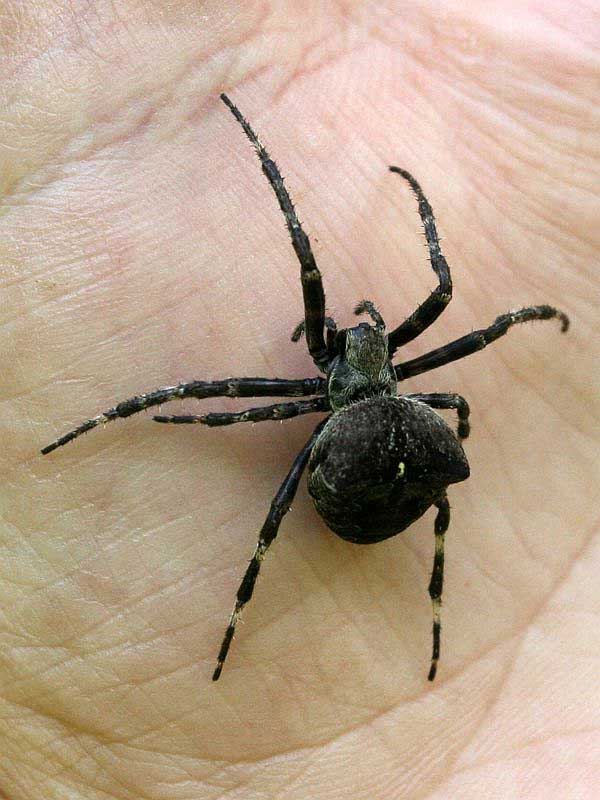
Araneus angulatus (*)
Superregnum: Eukaryota
Cladus: Unikonta
Cladus: Opisthokonta
Cladus: Holozoa
Regnum: Animalia
Subregnum: Eumetazoa
Cladus: Bilateria
Cladus: Nephrozoa
Cladus: Protostomia
Cladus: Ecdysozoa
Cladus: Panarthropoda
Phylum: Arthropoda
Subphylum: Chelicerata
Classis: Arachnida
Ordo: Araneae
Subordo: Opisthothelae
Infraordo: Araneomorphae
Taxon: Neocribellatae
Series: Entelegynae
Superfamilia: Araneoidea
Familia: Araneidae
Subfamilia: Araneinae
Tribus: Araneini
Genus: Araneus
Species: Araneus angulatus
Subspecies: A. a. afolius – A. a. angulatus – A. a. atricolor – A. a. crucinceptus – A. a. fuscus – A. a. iberoi – A. a. levifolius – A. a. niger – A. a. nitidifolius – A. a. pallidus – A. a. personatus – A. a. serifolius
Name
Araneus angulatus Clerck, 1758: 22
ZooBank: 3A626A4C-189C-4E14-B3E6-DA7F0AE4639E
References
Levi, H.W. 1971. The diadematus group of the orb-weaver genus Araneus north of Mexico (Araneae: Araneidae). Bulletin of the Museum of Comparative Zoology 141(4): 131–179. BHL Reference page. [See p. 142, and figs. 9-14; redescription]
Vernacular names
한국어: 모서리왕거미
русский: Угловатый крестовик
Araneus angulatus is a species of orb-weaving spiders found in the Palearctic realm. It resembles the European garden spider, Araneus diadematus, but has distinctive tubercles on its abdomen. The species was first described in Aranei Svecici in 1757, where it was the first species described, making Araneus angulatus the first scientific name of an animal that is still in use.
Description
Araneus angulatus closely resembles the more frequently encountered European garden spider, Araneus diadematus, but can be distinguished by the presence of angular tubercles on the abdomen.[1]
Distribution
Araneus angulatus is found across a wide geographical range in the Palearctic realm. It is widespread in Europe, although rarer in Northern Europe.[2] A. angulatus is rare in the United Kingdom, where it is restricted to areas near the South coast of England.[1]
Subspecies
Six subspecies are currently recognized:[3][4]
Araneus angulatus afolius (Franganillo, 1909) — Portugal
Araneus angulatus atricolor Simon, 1929 — France
Araneus angulatus levifolius (Franganillo, 1909) — Portugal
Araneus angulatus niger (Franganillo, 1918) — Spain
Araneus angulatus nitidifolius (Franganillo, 1909) — Portugal
Araneus angulatus personatus Simon, 1929
Much of the previous subspecies are now part of Araneus pallidus.
Ecology
A. angulatus constructs a large orb web, suspended from bushes and trees, often with support lines leading to the ground. Unlike A. diadematus, the web of A. angulatus has no retreat, so the spider must sit in the centre of the web while it waits for prey.[1] It detects prey items by vibrations they cause in the web, but has also been observed during a country fair, and reported to be "indifferent to crowds, music and fireworks".[5]
Taxonomic history
The illustration accompanying Clerck's description of Araneus angulatus in Aranei Svecici / Svenska Spindlar, showing a male and a female specimen
Wikispecies has information related to Araneus angulatus.
Wikimedia Commons has media related to Araneus angulatus.
Araneus angulatus was the first of the 66 species described in Carl Alexander Clerck's 1757 work Aranei Svecici / Svenska Spindlar.[6] Under the International Code of Zoological Nomenclature Svenska Spindlar has precedence over the 10th edition of Carl Linnaeus' Systema Naturae from 1758, and is therefore the first work to contain scientific names of animals that are still in use.[7]
References
Nick Loven. "Araneus angulatus". Nick's Spiders of Britain and Europe. Retrieved September 8, 2010.
Matjaž Kuntner (1997). "A contribution to the knowledge of the Slovenian spider fauna: eleven species new for Slovenia and some other interesting findings (Arachnida, Araneae)" (PDF). Proceedings of the 16th European Colloquium of Arachnology: 165–172. Archived from the original (PDF) on November 16, 2021.
"Araneus angulatus Clerck, 1757". Integrated Taxonomic Information System. Retrieved 29 November 2021.
Bern, Natural History Museum. "Araneus angulatus personatus Simon, 1929". wsc.nmbe.ch. NMBE - World Spider Catalog. Retrieved 29 November 2021.
Alfred Finck (1972). "Vibration sensitivity in an orb-weaver". American Zoologist. 12 (3): 539–543. doi:10.1093/icb/12.3.539. JSTOR 3881789.
Page 22 in Clerck, C. 1757. Svenska Spindlar uti sina hufvud-slågter indelte samt under några och sextio särskildte arter beskrefne och med illuminerade figurer uplyste. - Aranei Svecici, descriptionibus et figuris æneis illustrati, ad genera subalterna redacti, speciebus ultra LX determinati. - pp. [1-8], 1-154, pl. 1-6. Stockholmiæ. (L. Salvii).
International Commission on Zoological Nomenclature (1999). "Article 3. Starting point". International Code of Zoological Nomenclature (4th ed.). ISBN 0-85301-006-4.
Retrieved from "http://en.wikipedia.org/"
All text is available under the terms of the GNU Free Documentation License

